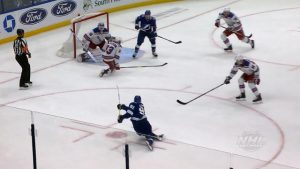Lawo Develops Hockey Version of Kick Action-Following Audio System
Puck automates the effects mix, making it more efficient
Story Highlights
Hockey fans may get a kick out of pucks, but Lawo has derived Puck out of Kick. The company is adapting its Kick platform — software that uses real-time tracking data to allow exact player, referee, and ball positions to be tracked through the audio console — for hockey.
Kick’s camera-based technology generates real-time tracking data of those field elements in the venue. From the venue’s microphones, the positions on the edge of the field, and directional characteristics, the system determines which microphone can best capture what is happening on the field at any given time and automatically sends the necessary commands to the mixing console to open the appropriate microphone’s channel. The software remotely controls channels on a Lawo mc2-series audio-mixing console or an mc2 Micro Core connected to a third-party console. The software automatically balances the relevant channels, depending on which field-of-play microphone is closest to the action.
According to Lawo Senior Product Manager, Audio Production, Christian Struck, Puck is based on the same principles, though modified for hockey’s faster pace and smaller object.
“Kick is optically based, using tracking data from the cameras to provide the information we need to track the ball,” he explains. “For Puck, the information will come from a transponder. But it doesn’t matter if the data comes in optically or through a transponder; the software still operates as the interface between the tracking data received and the digital mixing consoles used.”

Puck software automatically balances audio channels, depending on which field-of-play mic is closest to the action.
For soccer, tracking data has been derived from ChyronHego’s camera-based TRACAB tracking system, which is responsible for generating the official Bundesliga match data. The Puck system has been tested with hockey leagues and at least one broadcaster, although Struck declined to identify which leagues, teams, or networks have been involved.
He says that broadcasters, and in particular for the A1s who mix the shows, benefit from Puck’s automated approach to the effects mix, which makes the workflow more efficient, freeing the A1 and submixer to concentrate on other aspects of the mix. That, he emphasizes, will become more critical as immersive formats become more prevalent in broadcast sports.
“The A1 can concentrate on the other elements of the mix and on multiple delivery formats, instead of having to chase faders,” he notes.
No word on deployment yet, but Michael Mueller, VP, sales, North America, is confident that implementation will take place in 2019. Thus far, Kick has been deployed only by the German Football League DFL subsidiary Sportcast and used for Bundesliga matches.
“We’re seeing more and more automation make its way into the broadcast workflow,” says Mueller, citing increased production automation from switcher companies such as Ross and Grass Valley.
“The future is going to be very much data-driven,” he says. “We expect to see more of this type of application in the future.”
